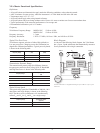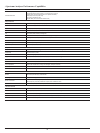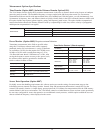
11
VNA Performance Capabilities (MS202x/3xC)
Measurement Parameters
S
11
, S
21
, S
22
, S
12
, S
d
1
d
1
, S
c
1
c
1
, S
d
1
c
1
, S
c
1
d
1
Number of Traces
Four: TR1, TR2, TR3, TR4
Trace Format
Single, Dual, Tri, Quad. When used with Number of Traces, overlays are possible including a Single Format with Four trace overlays.
Graph Types
Log Magnitude
SWR
Phase
Real
Imaginary
Group Delay
Smith Chart
Log Mag / 2 (1-Port Cable Loss)
Linear Polar
Log Polar
Real Impedance
Imaginary Impedance
Domains
Frequency Domain, Time Domain, Distance Domain
Frequency
Start Frequency, Stop Frequency, Center Frequency, Span
Distance
Start Distance, Stop Distance
Time
Start Time, Stop Time
Frequency Sweep Type: Linear
Single Sweep, Continuous
Data Points
2 to 4001 (arbitrary setting); data points can be reduced without recalibration.
Limit Lines
Upper, Lower, 10 segmented Upper, 10 segmented Lower
Test Limits
Pass/Fail for Upper, Pass/Fail for Lower, Limit Audible Alarm
Data Averaging
Sweep-by-sweep
Smoothing
0 to 20%
IF Bandwidth
10, 30, 100, 300, 1k, 3k, 10k, 30k, 100k (Hz)
Reference Plane
The reference planes of a calibration (or other normalization) can be changed by entering a line length. Assumes no loss, flat magnitude,
linear phase, and constant impedance.
Auto Reference Plane Extension
Instead of manually entering a line length, this feature automatically adjusts phase shift from the current calibration (or other normalization) to
compensate for external cables (or test fixtures). Assumes no loss, flat magnitude, linear phase, and constant impedance.
Frequency Range
Frequency range of the measurement can be narrowed within the calibration range without recalibration.
Group Delay Aperture
Defined as the frequency span over which the phase change is computed at a given frequency point. The aperture can be changed without
recalibration. The minimum aperture is the frequency range divided by the number of points in calibration and can be increased to 20% of the
frequency range.
Group Delay Range
< 180º of phase change within the aperture
Trace Memory
A separate memory for each trace can be used to store measurement data for later display. The trace data can be saved and recalled.
Trace Math
Complex trace math operations of subtraction, addition, multiplication, or division are provided.
Number of Markers
Eight, arbitrary assignments to any trace
Marker Types
Reference, Delta
Marker Readout Styles
Log Mag, Cable Loss (Log Mag / 2), Log Mag and Phase, Phase, Real and Imaginary, SWR, Impedance, Admittance, Normalized Impedance,
Normalized Admittance, Polar Impedance, and Group Delay, Linear Mag, Linear Mag and Phase
Marker Search
Peak Search, Valley Search, Find Marker Value
Correction Models
Full 2-Port, Full S
11
, Full S
22
, Full S
11
& S
22
, Response S
21
, Response S
12
, Response S
21
& S
12
, Response S
11
, Response S
22
,
Response S
11
& S
22
, One-Path Two-Port (S
11
,S
21
), One-Path Two-Port (S
22
,S
12
)
Calibration Methods
Short-Open-Load-Through (SOLT), Offset-Short (SSLT), and Triple-Offset-Short (SSST)
Calibration Standards’ Coefficients
Coax: N-Connector, K-Connector, 7/16, TNC, SMA, and four User Defined
Waveguide: WG11A, WG12, WG13, WG14, WG15, WG16, WG17, WG18, WG20, and four User Defined
Cal Correction Toggle
On/Off
Dispersion Compensation
Waveguide correction that improves accuracy of distance-to-fault data by compensating for different wavelengths propagating at different speeds.
Impedance Conversion
Support for 50 Ω and 75 Ω are provided.
Units
Meters, Feet
Bias Tee Settings
Internal, External, Off
Timebase Reference
Internal, External (10 MHz)
File Storage Types
Measurement, Setup (with CAL), Setup (without CAL), S2P (Real/Imag), S2P (Lin Mag/Phase), S2P (Log Mag/Phase), JPEG
Ethernet Configuration
DHCP or Manual (Static); IP, Gateway, Subnet entries
Languages
English, French, German, Spanish, Chinese, Japanese, Korean, Italian, plus two User Defined


















